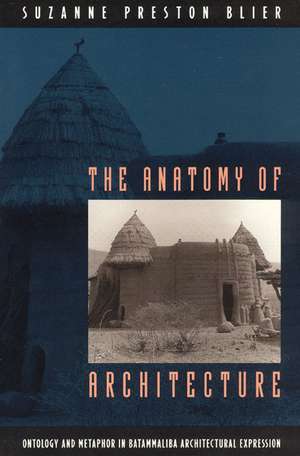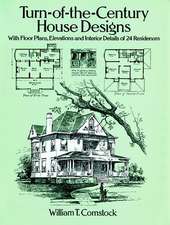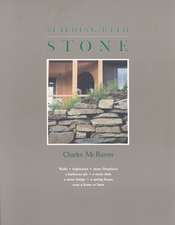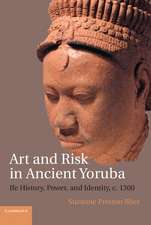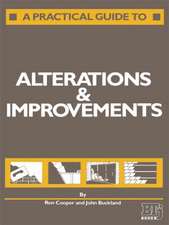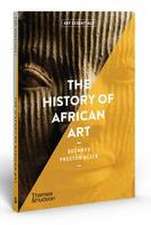The Anatomy of Architecture: Ontology and Metaphor in Batammaliba Architectural Expression
Autor Suzanne Preston Blieren Limba Engleză Paperback – 1995
Blier illuminates the extraordinary architecture of the Batammaliba people of Western Africa, revealing these buildings as texts through which we can read the beliefs, psychology, traditions, and social concerns of their inhabitants. In doing so, she explores the role of vernacular architecture as an expression of culture.
"A splendid analysis of the centrality of architecture in the daily lives of the Batammaliba and its integral role in articulating social values....The story is beautifully told in the best of anthropological traditions."—Judith R. Blau, Contemporary Society
"A remarkable study....Blier's volume carries the study of African architecture to a qualitatively new level of scholarship. It introduces a new dimension whereby the architectural medium can be used to illuminate much of the entire belief system of any culture."—Labelle Prussin, African Arts
"In this excellent book Blier provides a richly detailed and searching account of what architecture means to the Batammaliba of northern Togo and Benin....The finest account I have yet read of the relations between systems of beliefs, ritual practices, and African aesthetics and plastic arts....The ethnography and basic insight should be the envy of any social anthropologist."—T.O. Beidelman, Man
"A splendid analysis of the centrality of architecture in the daily lives of the Batammaliba and its integral role in articulating social values....The story is beautifully told in the best of anthropological traditions."—Judith R. Blau, Contemporary Society
"A remarkable study....Blier's volume carries the study of African architecture to a qualitatively new level of scholarship. It introduces a new dimension whereby the architectural medium can be used to illuminate much of the entire belief system of any culture."—Labelle Prussin, African Arts
"In this excellent book Blier provides a richly detailed and searching account of what architecture means to the Batammaliba of northern Togo and Benin....The finest account I have yet read of the relations between systems of beliefs, ritual practices, and African aesthetics and plastic arts....The ethnography and basic insight should be the envy of any social anthropologist."—T.O. Beidelman, Man
Preț: 296.49 lei
Nou
Puncte Express: 445
Preț estimativ în valută:
56.73€ • 59.24$ • 46.85£
56.73€ • 59.24$ • 46.85£
Carte tipărită la comandă
Livrare economică 16-30 aprilie
Preluare comenzi: 021 569.72.76
Specificații
ISBN-13: 9780226058610
ISBN-10: 0226058611
Pagini: 332
Ilustrații: 64 halftones, 2 maps, 20 line drawings
Dimensiuni: 152 x 229 x 25 mm
Greutate: 0.55 kg
Ediția:1
Editura: University of Chicago Press
Colecția University of Chicago Press
ISBN-10: 0226058611
Pagini: 332
Ilustrații: 64 halftones, 2 maps, 20 line drawings
Dimensiuni: 152 x 229 x 25 mm
Greutate: 0.55 kg
Ediția:1
Editura: University of Chicago Press
Colecția University of Chicago Press
Cuprins
Illustrations
Linguistic Note
Preface and Acknowledgments
Introduction
Ch. 1: Imagines Mundi: Narrative, Ritual, and Architectural Exemplars of Cosmogony
Ch. 2: Architectural Archetypes: Reflections on Housing in "Paradise"
Ch. 3: House Temples: Architecture for the Gods
Ch. 4: Houses Are Human: Architectural Self-images
Ch. 5: At Home: The Complementarity of House, Family, and Tomb
Ch. 6: The Power of Architecture: Politics, Protection, and Jurisprudence in House Design and Use
Ch. 7: "The Dance of Drums": Notes on the Architecture and Staging of Funeral Performances
Conclusions: Architectural Exegesis: On Building Ontology, Metaphor, and Multiplexity
Notes
Bibliography
Linguistic Note
Preface and Acknowledgments
Introduction
Ch. 1: Imagines Mundi: Narrative, Ritual, and Architectural Exemplars of Cosmogony
Ch. 2: Architectural Archetypes: Reflections on Housing in "Paradise"
Ch. 3: House Temples: Architecture for the Gods
Ch. 4: Houses Are Human: Architectural Self-images
Ch. 5: At Home: The Complementarity of House, Family, and Tomb
Ch. 6: The Power of Architecture: Politics, Protection, and Jurisprudence in House Design and Use
Ch. 7: "The Dance of Drums": Notes on the Architecture and Staging of Funeral Performances
Conclusions: Architectural Exegesis: On Building Ontology, Metaphor, and Multiplexity
Notes
Bibliography
